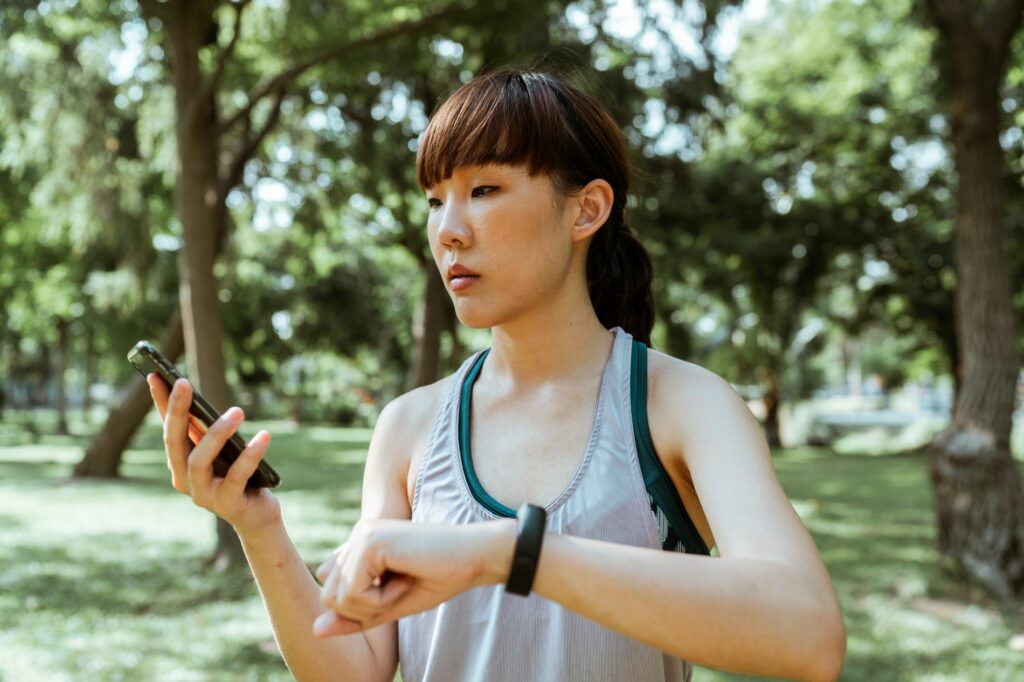In our world today, there are lots of tech wearables focused on health and fitness on the market. The stated features of these wearables tend to include step tracking, sleep data, movement reminders, and very often, calories burned.
Today, I want to explore the four ways your body burns energy, or calories, and ask the question: is your smart device actually smart when it comes to how your body uses energy?
What is a calorie?
A calorie is a unit of measure for the energy in food. It comes from the amount of heat required to raise the temperature of 1 kilogram of water from 0 to 1 degree celsius. Technically a calorie, as we commonly refer to it, is actually a kilocalorie or kcal. So if you see food packaging using kcal instead of cal, just know it’s essentially the same thing.
The food we eat can be broken down into three main categories called macronutrients. Each macronutrient has its own calorie quotient or number of calories per gram, and each is consumed and used by the body differently.

Macronutrients are your building blocks.
There are three macronutrients: carbohydrates, fats, and proteins. All three serve important roles in supplying energy to your body.
Macronutrients each have their own caloric value and will be consumed by your body differently.
Carbohydrates: 4 calories per gram
Fats: 9 calories per gram
Protein: 4 calories per gram
Alcohol: 7 calories per gram
Technically, alcohol is also a macronutrient. However, it is often not associated with the other three as a primary fuel source for the body, given its obvious deleterious effects.
Still with me? Great! Now let’s get back to calories burned.
A fitness tracker often uses the data point of calories burned, in relation to either one workout, movement over a day, or both. This is where we unmask a slight problem in the accuracy of your smart device giving you data about your caloric burn.
Why might tracking calories on your tech device be problematic?
First, there is the assumption that the device is 100% accurate all of the time. Secondly, there is the assumption that the device tracks all forms of calories burned during the day.
So hypothetically, you seek out an active lifestyle and workout most days of the week. At the end of the week, your device tells you that you averaged 1,400 calories burned per day. You know you want to lose weight, so you decide that you will just eat 200 less calories per day (1,200 total) and that will get you to your weight goal! Right?
Before continuing, let’s put a pin in that hypothetical and consider a few more principles of caloric needs.

How do I know how many calories I burn in a day?
The term Total Daily Energy Expenditure (TDEE) is the umbrella term for describing the amount of calories (energy) we burn during a day. It can be broken down into four categories.
- Basal Metabolic Rate (BMR)
- Thermic Effect of Food (TEF)
- Exercise Energy Expenditure (EEE)
- Non-Exercise Activity Thermogenesis (NEAT)
Basal Metabolic Rate (BMR) is the number of calories the body needs to stay alive while keeping its organs functioning in a resting state. This number alone, depending on the individual, can equate to more calories burned than the other three combined. Body composition is one large influence of BMR; as well as your age, height, and gender.
Thermic Effect of Food (TEF) is the energy your body uses to eat and digest food. Did you ever think about the fact that it actually takes energy (calories) to eat, then digest, your food? So if 100 calories were consumed, a portion of that would be used purely to support the digestive process. To tie in the macronutrients we discussed earlier, here’s the TEF of each macro:
Carbohydrate – At 4 calories per gram, its TEF is roughly 5-10%
Fats – At 9 calories per gram, its TEF is roughly 0-3%
Protein – At 4 calories per gram, its TEF is roughly 20-30%
The percentage point means, of the calories consumed that percentage is used just to eat it.
If you are eating 20 grams of protein, at 80 calories with 25% TEF, then 20 calories would be used just to digest your protein. Netting in 60 calories being able to be used elsewhere in the body.
Exercise Energy Expenditure (EEE) is the energy your body burns when you workout. Typically this could be between 200 and 500 calories depending on the individual, activity, intensity, and duration.
Non-Exercise Activity Thermogenesis (NEAT) are all the things you do outside of a traditional workout, which also burn calories. Walking around the house, doing laundry, fidgeting, driving and thinking all take energy. You have likely heard this term discussed in a different way in the context of sedentary lifestyle. Usually when a sedentary lifestyle is discussed, people are talking about ways to move more, beyond formal exercise. This is exactly what NEAT is.
As you just read, there are four ways we burn calories or use energy throughout the day, and we need to ask the question: how do calorie trackers stack up in measuring each of these?

Your Calorie Tracker Is Misleading You
First, many calorie trackers only attempt to measure three of the four parts of TDEE. Those parts are BMR, EEE, and NEAT. Trackers do not measure TEF because they have no accurate way to measure it. The device doesn’t know how much you’re eating and it can’t know your macronutrient ratios. At best, the device can make a guess based on an internal algorithm. If you are trying to be strict on your calorie intake, then a guess isn’t going to be useful.
But at least it tracks three of the four parts of TDEE! Right?
True. But its tracking methods are riddled with faults.
BMR, for example, is typically calculated from heart rate, height, sex, and bodyweight.
These are all relevant data points. But let’s dive deeper into the weight measurement. Body composition and weight are two different things. Weight is the number on the scale whereas body composition is the ratio between skeletal muscle mass, bones, total body water, and body fat.
The difference between weight and body composition is important. A 5’10” 180 pound man that is well hydrated and at 13% body fat will look very different from a 5’10” 180 pound man that is well hydrated at 23% body fat. They will also have notably different BMR’s. Again, another flaw in the system.
It only gets worse with Exercise Energy Expenditure and Non-Exercise Activity Thermogenesis .
In 2017, Stanford Medicine conducted a study on the accuracy of these wearable devices. The study found the following.
A Stanford inquiry into the accuracy of seven wristband activity monitors (Apple Watch, Basis Peak, Fitbit Surge, Microsoft Band, Mio Alpha 2, PulseOn and the Samsung Gear S2) showed that six out of seven devices measured heart rate within five percent. The study found that none of the devices measured energy expenditure well. Energy expenditure here would include EEE and NEAT.
“Even the most accurate device was off by an average of 27 percent. And the least accurate was off by 93 percent.”
Clearly the accuracy of these devices is a huge problem. Again, using the hypothetical of someone wanting to lose weight, you can see how a calorie tracking device with a 27% to 93% inaccuracy could drastically affect the number of calories a person believes they are supposed to eat.

Tying Up Loose Ends
I’ve spent the last few pages discussing some specific details about caloric intake. But all this information, however accurate and true it might be, is still lacking.
So what’s missing? Energy, rhythm, balance, and purpose.
That’s what’s missing. The intentions you have behind your eating habits matter. Your intentions will help inform you about what to eat and how to eat for a lifetime.
Therefore, I would suggest that your nutritional practices should not be based around a calories burned number. Instead, take a more holistic approach in determining how to eat and fuel your body for the life that you want to live.
To be honest, I could go on for another twenty pages discussing this holistic approach because I find it fascinating. But for the time being, I’ll leave you with some very straightforward and actionable steps, we at OPEX call the Basic Lifestyle Guidelines, or BLG’s for short. Implementing these principles into your life will not only allow you to see the body composition changes you desire, but more importantly, it will help you live a life full of vitality and enjoyment.
For a quick conversation to answer any of your questions, or to find out more about how OPEX Lancaster can support you toward your goals, please hit the link below and send us a message. We would love to help you shine a light on what can be a very confusing path toward your best health.
Sources
Interested in reading more about this topic? Here are the links to the sources used to write this post.
https://nutritionj.biomedcentral.com/articles/10.1186/1475-2891-6-44
https://www.nal.usda.gov/fnic/what-difference-between-calories-and-kilocalories
https://examine.com/topics/thermic-effect-of-food/
https://www.opexfit.com/blog/how-to-calculate-tdee-total-daily-energy-expenditure
https://help.fitbit.com/articles/en_US/Help_article/1141.htm
https://support.whoop.com/hc/en-us/articles/360033775513-How-does-WHOOP-calculate-calories-burned-
